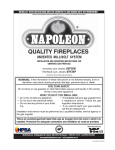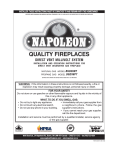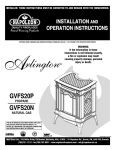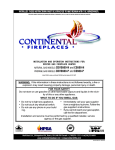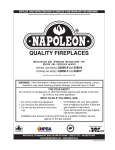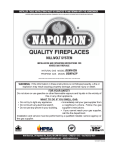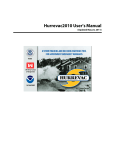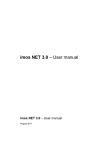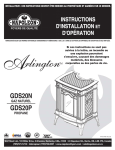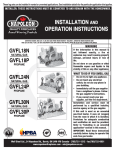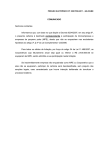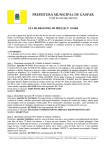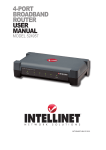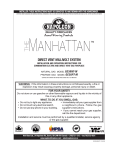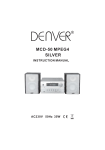Download Napoleon Fireplaces GVFS60-P User's Manual
Transcript
1 INSTALLER: THESE INSTRUCTIONS MUST BE CONVEYED TO AND REMAIN WITH THE HOMEOWNER CERTIFIED UNDER AMERICAN NATIONAL STANDARDS, ANSI Z21.11.2b, VOLUME II FOR UNVENTED ROOM HEATERS. UNVENTED MILLIVOLT SYSTEM INSTALLATION AND OPERATION INSTRUCTIONS FOR UNVENTED GAS FIREPLACE GVFS60-N MODEL GVFS60-P NATURAL GAS MODEL PROPANE GAS CERTIFIED FOR THE UNITED STATES USING ANSI / AGA METHODS WARNING: If the information in these instructions is not followed exactly, a fire or explosion may result causing property damage, personal injury or death. FOR YOUR SAFETY Do not store or use gasoline or other flammable vapours and liquids in the vicinity of this or any other appliance. WHAT TO DO IF YOU SMELL GAS: • Do not try to light any appliance. • Immediately call your gas supplier from a • Do not touch any electrical switch. neighbour's phone. Follow the gas • Do not use any phone in your building. supplier's instructions. • If you cannot reach your gas supplier, call the fire department. Installation and service must be performed by a qualified installer, service agency or the gas supplier. This is an unvented gas-fired heater that uses air (oxygen) from the room in which it is installed. Provisions for adequate combustion and ventilation air must be provided. Wolf Steel Ltd., RR#1, 9 Napoleon Rd., Barrie, ON., Canada L4M 4Y8 (705)721-1212 Fax: (705)722-6031 Email: [email protected] Web: www.napoleon.on.ca W415-0204 / C / 10.02.01 2 TABLE OF CONTENTS PG 3-4 INTRODUCTION PG 9 Warranty General Instructions Shipping Bracket Mobile home installation General Information 5 5-7 10-11 7-8 12 INSTALLATION FINISHING OPERATION / MAINTENANCE Operating Instructions Maintenance Oxygen Depletion Sensor Pilot Cleaning Venturi Adjustment LOCATIONS & CLEARANCES Combustion and Ventilation Air Provisions Installation Examples Gas Installation BLOWER INSTALLATION REPLACEMENTS Ordering Replacement Parts Replacement Parts Accessories 13-14 TROUBLE SHOOTING GUIDE Front Casting Installation Log Placement PLEASE RETAIN THIS MANUAL FOR FUTURE REFERENCE WARNING • Under no circumstances should this heater be modified. • Provide adequate ventilation and combustion air. Provide adequate accessibility clearance for servicing and operating the heater. Never obstruct the front opening of the heater. • If heater shuts off, do not re-light until you provide fresh air. If heater keeps shutting off, have it serviced. Keep burner and control compartment clean. • Do not burn wood or other materials in this heater. • Adults and especially children should be alerted to the hazards of high surface temperatures and should stay away to avoid burns or clothing ignition. Supervise young children when they are in the same room as the heater. • Due to high temperatures, the heater should be located out of traffic and away from furniture and draperies. • Clothing or other flammable material should not be placed on or near the heater. • Any safety screen or guard removed for servicing must be replaced prior to operating the heater. • It is imperative that the control compartments, burners and circulating air passageways in the heater are kept clean. The heater should be inspected before use and at least annually by a qualified service person. More frequent cleaning may be required due to excessive lint from carpeting, bedding material, etc. The heater area must be kept clear and free from combustible materials, gasoline and other flammable vapours and liquids. • Furniture or other objects must be kept a minimum of 4 feet away from the front of the fireplace. • Do not use this heater if any part has been under water. Immediately call a qualified service technician to inspect the heater and to replace any part of the control system and any gas control which has been under water. ANY CHANGE T O THIS HEA TER OR ITS CONTROL S CAN BE D ANGEROUS AND IS PROHIBITED TO HEATER CONTROLS DANGEROUS PROHIBITED.. W415-0204 / C / 10.02.01 3 NAPOLEON gas fireplaces are manufactured under the strict Standard of the world recognized ISO9002 Quality Assurance Certificate. NAPOLEON products are designed with superior components and materials, assembled by trained craftsmen who take great pride in their work. The burner and valve assembly are leak and test-fired at a quality test station. The complete fireplace is test-fired and thoroughly inspected by a qualified technician before packaging to ensure that you, the customer, receives the quality product that you expect from NAPOLEON. NAPOLEON GAS FIREPLACE PRESIDENT'S LIFETIME LIMITED WARRANTY The following materials and workmanship in your new NAPOLEON gas fireplace are warranted against defects for as long as you own the fireplace. This covers: combustion chamber, heat exchanger, stainless steel burner, phazer™ logs and embers, ceramic glass (thermal breakage only), gold plated parts against tarnishing, porcelainized enamelled components and aluminum extrusion trims. Electrical (110V and millivolt) components and wearable parts such as catalytic tiles, blowers, gas valves, thermal switch, switches, wiring, remote controls, ignitor, gasketing, and pilot assembly are covered and NAPOLEON will provide replacement parts free of charge during the first year of the limited warranty. Labour related to warranty repair is covered free of charge during the first year. Repair work, however, requires the prior approval of an authorized company official. Labour costs to the account of NAPOLEON are based on a predetermined rate schedule and any repair work must be done through an authorized NAPOLEON dealer. CONDITIONS AND LIMITATIONS NAPOLEON warrants its products against manufacturing defects to the original purchaser only -- i.e., the individual or legal entity (registered customer) whose name appears on the warranty registration card filed with NAPOLEON -- provided that the purchase was made through an authorized NAPOLEON dealer and is subject to the following conditions and limitations: This factory warranty is nontransferable and may not be extended whatsoever by any of our representatives. The gas fireplace must be installed by a licenced, authorized service technician or contractor. Installation must be done in accordance with the installation instructions included with the product and all local and national building and fire codes. This limited warranty does not cover damages caused by misuse, lack of maintenance, accident, alterations, abuse or neglect and parts installed from other manufacturers will nullify this warranty. This limited warranty further does not cover any scratches, dents, corrosion or discolouring caused by excessive heat, abrasive and chemical cleaners nor chipping on porcelain enamel parts, mechanical breakage of PHAZER™ logs and embers, nor any venting components used in the installation of the fireplace. NAPOLEON warrants its stainless steel burners against defects in workmanship and material for life, subject to the following conditions: During the first 10 years NAPOLEON will replace or repair the defective parts at our option free of charge. From 10 years to life, NAPOLEON will provide replacement burners at 50% of the current retail price. In the first year only, this warranty extends to the repair or replacement of warranted parts which are defective in material or workmanship provided that the product has been operated in accordance with the operation instructions and under normal conditions. After the first year, with respect to this President's Limited Lifetime Warranty, NAPOLEON may, at its discretion, fully discharge all obligations with respect to this warranty by refunding to the original warranted purchaser the wholesale price of any warranted but defective part(s). After the first year, NAPOLEON will not be responsible for installation, labour or any other costs or expenses related to the reinstallation of a warranted part, and such expenses are not covered by this warranty. Notwithstanding any provisions contained in this President's Limited Lifetime Warranty, NAPOLEON’S responsibility under this warranty is defined as above and it shall not in any event extend to any incidental, consequential or indirect damages. This warranty defines the obligations and liability of NAPOLEON with respect to the NAPOLEON gas fireplace and any other warranties expressed or implied with respect to this product, its components or accessories are excluded. NAPOLEON neither assumes, nor authorizes any third party to assume, on its behalf, any other liabilities with respect to the sale of this product. NAPOLEON will not be responsible for: over-firing, downdrafts, spillage caused by environmental conditions such as rooftops, buildings, nearby trees, hills, mountains, inadequate vents or ventilation, excessive venting configurations, insufficient makeup air, or negative air pressures which may or may not be caused by mechanical systems such as exhaust fans, furnaces, clothes dryers, etc. Any damages to fireplace, combustion chamber, heat exchanger, brass trim or other component due to water, weather damage, long periods of dampness, condensation, damaging chemicals or cleaners will not be the responsibility of NAPOLEON. The bill of sale or copy will be required together with a serial number and a model number when making any warranty claims from your authorized dealer. The warranty registration card must be returned within fourteen days to register the warranty. NAPOLEON reserves the right to have its representative inspect any product or part thereof prior to honouring any warranty claim. ALL SPECIFICATIONS AND DESIGNS ARE SUBJECT TO CHANGE WITHOUT PRIOR NOTICE DUE TO ON-GOING PRODUCT IMPROVEMENTS. NAPOLEON® IS A REGISTERED TRADEMARK OF WOLF STEEL LTD. PATENTS U.S. 5.303.693.801 - CAN. 2.073.411, 2.082.915. © WOLF STEEL LTD. NOTE: Changes, other than editorial, are denoted by a vertical line in the margin. W415-0204 / C / 10.02.01 4 GENERAL INSTRUCTIONS THIS GAS FIREPLACE SHOULD BE INSTALLED AND SERVICED BY A QUALIFIED INSTALLER to conform with local codes. In absence of local codes, install the GVFS60 to the current National Fuel Gas Code, ANSI Z223.1 Installation Code which can be obtained from: American Nation Standards Institute Inc. 1430 Broadway New York, NY 10018 or National Fire Protection Association Inc. Batterymarch Park Quincy, MA 02269 The fireplace and its individual shutoff valve must be disconnected from the gas supply piping system during any pressure testing of that system at test pressures in excess of ½ psig (3.5 kPa). The fireplace must be isolated from the gas supply piping system by closing its individual manual shutoff valve during any pressure testing of the gas supply piping system at test pressures equal to or less than ½ psig (3.5 kPa). The stove, when installed with a blower, must be electrically connected and grounded in accordance with local codes. In the absence of local codes, use the current ANSI/NFPA 70-1996 NATIONAL ELECTRICAL CODE. The blower power cord must be connected into a properly grounded receptacle. The grounding prong must not be removed from the cord plug. SHIPPING BRACKET To avoid the stove being damaged during shipping, a shipping bracket has been used and must be unbolted before the stove can be installed. 1. Remove the four nuts holding the shipping bracket to the bottom of the stove. 2. Lift the stove up and away from the skid to clear the threaded bolts sticking through the bracket. Set down on a flat surface. The stove top is not secured to the unit. 3. Discard the nuts, bracket and the skid. 4 NUTS SHIPPING BRACKET MOBILE HOME INSTALLATION Suitable for mobile home installation where the mobile home has been permanently placed on its site. This fireplace may be installed in an aftermarket permanently located, manufactured (mobile) home, where not prohibited by local codes. For mobile home installations, the fireplace must be fastened in place. It is recommended that the fireplace be secured in all installations. Use the levelling / securing kit, GDSLL-KT, for this purpose. GENERAL INFORMATION FOR YOUR SATISFACTION, THIS FIREPLACE HAS BEEN TEST-FIRED TO ASSURE ITS OPERATION AND QUALITY! Maximum input is 30,000 BTU/hr for natural gas and propane. When the fireplace is installed at elevations above 2,000ft, and in the absence of specific recommendations from the local authority having jurisdiction, the certified high altitude input rating shall be reduced at the rate of 4% for each additional 1,000ft. This heater must not be installed in a bedroom or bathroom. This fireplace is only for use with the type of gas indicated on the rating plate. This fireplace is not convertible for use with other gases, unless a certified kit is used. Minimum inlet gas supply pressure is 4.5 inches water column for natural gas and 11 inches water column for propane. Maximum inlet gas pressure is 7 inches water column for natural gas and 13 inches water column for propane. Manifold pressure under flow conditions is 3.5 inches water column for natural gas and 10 inches water column for propane. No external electricity (110 volts or 24 volts) is required for the gas system operation. Expansion / contraction noises during heating up and cooling down cycles are normal and are to be expected. This heater is equipped with a pilot light safety system referred to as an OXYGEN DEPLETION SENSOR and is designed to turn off the heater if not enough fresh air is available. Use only accessories designed for and listed with your specific fireplace. CARBON MONOXIDE POISONING MAY LEAD TO DEATH Early signs of carbon monoxide poisoning resemble the flu, with headache, dizziness and/ or nausea. If you have these signs, the heater may not be working properly. Get fresh air at once! Have heater serviced. FIGURE 1 W415-0204 / C / 10.02.01 Some people---pregnant women, persons with heart or lung disease, anemia, those under the influence of alcohol, those at high altitudes--- are more affected by carbon monoxide than others. 5 LOCATION AND CLEARANCES Provide adequate ventilation and combustion air. Provide adequate accessibility clearance for servicing and operating the stove. MAINTAIN THESE MINIMUM CLEARANCES TO COMBUSTIBLES: Never obstruct the front opening of the stove. As long as clearance to combustibles is kept within the required distances, the most desirable and beneficial location for a Napoleon stove is in the centre of a building, thereby allowing the most efficient use of the heat created. The location of windows, doors and the traffic flow in the room where the stove is to be located should be considered. FIGURE 3 A. 6" 15½" C. 2"* NO ADDITIONAL FLOOR PROTECTION IS REQUIRED. MINIMUM 46" FROM STOVE TOP TO CEILING. * AT A DISTANCE OF 2” FROM THE WALL, ACCESS TO THE BLOWER SWITCH, ON-OFF SWITCH OR THE BLOWER POWER CORD MAY NOT BE PRACTICAL. 29 7/8" 25½" B. 6" FIGURE 2 INSTALL ATION COMBUSTION AND VENTILATION AIR PROVISIONS This heater shall not be installed in a confined space or unusually tight construction unless provisions are provided for adequate combustion and ventilation air. This fireplace must be installed against a finished wall. Do not install against a vapour barrier or exposed insulation. The National Fuel Gas Code, ANSI Z223.1 defines a confined space as a space whose volume is less than 50 cubic feet per 1,000 Btu per hour (4.8 m3 per kw) of the aggregate input rating of all appliances installed in that space and an unconfined space as a space whose volume is not less than 50 cubic feet per 1,000 Btu per hour (4.8 m3 per kw) of the aggregate input rating of all appliances installed in that space. Rooms communicating directly with the space in which the appliances are installed, through openings not furnished with doors are considered a part of the unconfined space. DETERMINING CONFINED OR UNCONFINED SPACE: To determine the volume of the room where the heater is to be installed, multiply the width x the length x the ceiling height of that room measured in feet. If any adjoining rooms are connected by grills or openings such as kitchen passthroughs, etc., the volume of those rooms may be added to the total. Multiply the room volume by 1000 and divide this amount by 50 to determine the maximum Btu/hr that the space can support with adequate combustion and ventilation air. Add the Btu/hr of all fuel burning appliances located within the space such as gas furnace, gas water heater, etc. Do not include direct vent gas appliances which draw their input and output air from and to the outdoors. WARNING: If the area in which the heater may be operated is smaller than that defined as an unconfined space or if the building is of unusually tight construction, provide adequate combustion and ventilation air by one of the methods described in the National Fuel Gas Code ANSI Z223.1, Section 5.3 or the applicable local code. The GVFS60 is rated at 30,000BTUs per hour and therefore requires a minimum unconfined space of 1,500 cubic feet. W415-0204 / C / 10.02.01 6 Room Volume = Length x Width x Height Max BTU/hr = Room Volume x 1000 ÷ 50 ROOM 2 ROOM 1 FIGURE 4 HEIGHT LENGTH W ID H T If for example, the length of the rooms is 10 feet, the width of Room 1 is 10 feet, the width of Room 2 is 15 feet the height of the rooms is 8 feet. The volume of Room 1: 10 x 10 x 8 = 800 cubic feet. The volume of Room 2: 10 x 15 x 8 = 1200 cubic feet. EXAMPLE 1 In this example, because there is no door to the adjoining room, the volume of the adjoining room may be added to the volume of the room with the heater to get a total unconfined space. The total unconfined space: 800 + 1200 = 2000 cubic feet. Maximum BTU/h: 2000 x 1000 50 = 40,000 BTU/h If there are no more fuel burning appliances within this space then the 30,000 BTU/h input of the fireplace is suitable to be installed. This also assumes that the construction of this space is not unusually tight. EXAMPLE 2 If in this example a solid door separates Room 1 from Room 2, the volume of Room 2 could not be used. In this case the maximum BTU/h would be: Maximum BTU/h: 800 x 1000 50 = 16,000 BTU/h This would be considered a confined space since it can not support the 30,000BTU/h input of the heater and it would be necessary to provide adequate combustion and ventilation air to Room 1. Unusually tight construction is defined as construction where: a) Walls and ceilings exposed to the outside atmosphere have a continuous water vapour retarder with a rating of 1 perm (6 x 10-11 kg per pa-sec-m2) or less with openings gasketed or sealed, and b) Weather stripping has been added on openable windows and doors, and c) Caulking or sealants are applied to areas such as joints around window and door frames, between sole plates and floors, between wall-ceiling joints, between wall panels, at penetrations for plumbing, electrical, and gas lines, and at other openings. An unvented room heater is recommended for use as a secondary heat source rather than as a primary source. Gas combustion produces water vapour which could occur at the rate of approximately one ounce of water for every 1,000 BTU/hr of gas input. During the cold weather season, indoor humidity levels tend to be low. Consequently, this water vapour can enhance the living space. However if a problem should occur: a) ensure sufficient combustion and circulation air b) use a dehumidifier c) do not use the unvented room heater as a primary heat source Without sufficient fresh air for proper operation, poor fuel combustion can result. Carbon Monoxide is a result of poor combustion. If additional fresh air is required, use one of the methods described in the National Fuel Gas Code, ANSI Z223.1, Section 5.3 or the applicable local code. W415-0204 / C / 10.02.01 7 Attach the two leads to terminals 1 and 3 located on the gas valve. O ON FF FIGURE 6 1 2 PL T DO NOT KINK FLEX CONNECTOR. LO 1. Move the stove into position. We recommend securing the stove to the floor, in all cases. Levelling / securing kit GDSLL-KT may be used for this purpose. 2. Install rigid black pipe, 1/2" type-L copper tubing or, if local codes permit, a 3/8" flex connector and shutoff valve to the gas line and the fireplace gas valve. Seal and tighten securely. An adapter fitting is required between the gas valve and the copper tubing or flex connector. 4. For ease of accessibility, an optional remote wall switch or millivolt thermostat may be installed in a convenient location. Route a 2 strand, solid core millivolt wire from the stove to the wall switch or millivolt thermostat. The recommended maximum lead length depends on wire size: WIRE SIZE MAX. LENGTH 14 gauge 100 feet 16 gauge 60 feet 18 gauge 40 feet IH GAS INSTALLATION O I FIGURE 5 3. Check for gas leaks by brushing on a soap and water solution. DO NOT USE OPEN FLAME. PI L OT 3 DO NOT CONNECT EITHER THE WALL SWITCH, THERMOSTAT OR GAS VALVE TO ELECTRICITY (110 VOLTS). It is not necessary to install a hearth extension with this fireplace system. Objects placed in front of the fireplace should be kept a minimum of 4 feet away from the front face. FINISHING FRONT CAST INSTALLATION TOP FIGURE 7b CAST FRONT SECURING BOLTS RETAINER MESH SECURING BOLTS FIGURE 7a FRONT 2. Lift the top casting off the unit. 3. Fit the securing bolts on the cast front into each of the respective retainer brackets (located at either side on the top). Insert and tighten the securing screw from the bottom up (located at the lower center behind the cast front). This will hold the cast front in place. Replace the top casting. 4. To remove the front, repeat in reverse order. 1. Place the cast front face down on a protective surface such as a carpet or blanket to avoid scratching the finished surface. Attach the screen to the inside of the front using four bolts and washers. FIGURE 7c SECURING SCREW W415-0204 / C / 10.02.01 8 LOG PLACEMENT INSTRUCTIONS Blocked burner ports can cause an incorrect flame pattern, carbon deposits and delayed ignition. PHAZERTM logs glow when exposed to direct flame and provide a unique and realistic glowing effect. Use only certified PHAZERTM logs available from your Napoleon / Wolf Steel Ltd. dealer. The notch in log #5 should be pressed down onto the skewering pin located at the end of the grate as shown to prevent it from rocking. 3 #6 1 FIGURES 8a-d #1 #3 #4 Position the notch located in log #6 against the grate post. 4 #2 Place log #1 onto the burner, centering it onto the burner tray and pushing it as close to the rear wall of the firebox as possible. Move logs # 2 and 3 into position, lining up the studs located on the burner with the holes on the bottom of the logs. Sit the notch at the bottom of log #4 against the left outermost grate post and position the top of the log into the pocket provided on the rear log (#1). 2 #5 #7 Place the bottom of log #7 against the right outermost grate post and the top into the pocket provided on the center log (#6). Tear the glowing embers into pieces and place onto the front of the burner. Care should be taken to shred the embers into thin, small irregular pieces as only the exposed edges of the fibre hairs will glow when exposed to direct flame; however care should be taken to not block the burner ports. Blocked ports can cause an incorrect flame pattern, carbon deposits and delayed ignition. Log colours may vary. During the initial use of the fireplace, the colours will become more uniform as colour pigments burn in during the heat activated curing process. POSITIONING THE LOGS IMPROPERLY WILL CAUSE FLAME IMPINGEMENT AND CARBONING. W415-0204 / C / 10.02.01 9 BLOWER INSTALLATION ON/OFF SWITCH BRACKET 4. Remove the 2 screws from the top outer edge of the rear stove panel. The housing is mounted using these two holes, as well as two other holes located in the rear panel. 5. Mount and secure the blower housing using 4 screws. Ensure that the on/off switch wires pass through the appropriate slot located on either side of the blower housing. 6. Remove the 2 screws from the side of the blower housing that you want the switch to be located on and re-secure the on/off switch. COVER PLATE ACCESS PLATE FIGURE 9 1. Ensure that the access cover plate has been installed. 2. Remove the on/off switch bracket and the cover plate below it. The cover plate may now be discarded. 3. Decide which side of the blower housing you prefer the on/off switch to be located on. SLOT FIGURE 11 Because the blower is thermally activated, when turned on, it will automatically start approximately 15-30 minutes after lighting the stove and will run for approximately 30-45 minutes after the stove has been turned off. Use of the fan increases the output of heat. Drywall dust will penetrate into the blower bearings, causing irreparable damage. Care must be taken to prevent drywall dust from coming into contact with the blower or its compartment. Any damage resulting from this condition is not covered by the warranty policy. REMOVED SCREWS FIGURE 10 W415-0204 / C / 10.02.01 10 OPERATION / MAINTENANCE OPERATING INSTRUCTIONS If heater shuts off, do not relight until you provide fresh air. If heater keeps shutting off, have it serviced. Keep burner and control compartment clean. When lit for the first time, the fireplace will emit a slight odour for a few hours. This is a normal temporary condition caused by the curing of the logs and the "burn-in" of internal paints and lubricants used in the manufacturing process and will not occur again. After extended periods of non-operation such as following a vacation or a warm weather season, the fireplace may emit a slight odour for a few hours. This is caused by dust particles burning off. In both cases, open a window to sufficiently ventilate the room. FOR YOUR SAFETY READ BEFORE OPERATING WARNING: IF YOU DO NOT FOLLOW THESE INSTRUCTIONS EXACTLY, A FIRE OR EXPLOSION MAY RESULT CAUSING PROPERTY DAMAGE, PERSONAL INJURY OR LOSS OF LIFE. ON FF P O C. Use only your hand to push in and turn the gas control knob. Never use tools. If the knob will not push in and turn by hand, do not try to repair it. Call a qualified service technician. Force or attempted repair may result in a fire or explosion. D. Do not use this fireplace if any part has been under water. Immediately call a qualified service technician to inspect the fireplace and replace any part of the control system and any gas control which has been under water. WHAT TO DO IF YOU SMELL GAS: • Do not try to light any appliance. • Do not touch any electric switch; do not use any phone in your building. • Immediately call your gas supplier from a neighbour's phone. Follow the gas supplier's instructions. • If you cannot reach your gas supplier, call the fire department. L T O I A. This fireplace is equipped with a pilot which must be lit by hand while following these instructions exactly. B. Before operating smell all around the fireplace area for gas and next to the floor because some gas is heavier than air and will settle on the floor. OXYGEN DEPLETION SENSOR GAS KNOB LIGHTING INSTRUCTIONS GAS KNOB AT OFF O ON FF PLT STOP! Read the above safety information on this label. Set the thermostat to lowest setting. Turn off all electric power to the fireplace. Open the control door. Turn the gas knob clockwise to off. 5. Wait five (5) minutes to clear out any gas. If you smell gas including near the floor, STOP! Follow "B" in the above safety information on this label. If you don't smell gas go to the next step. 6. Find pilot located in front of the back log. 7. Turn gas knob counter-clockwise to pilot. LO 1. 2. 3. 4. 8. Depress and hold gas knob while lighting the pilot with the push button ignitor. Keep knob fully depressed for one minute, then release. If pilot does not continue to burn repeat steps 3 through 7. to 9. With pilot lit, turn gas knob counter-clockwise on. 10. If equipped with remote on-off switch, main burner may not come on when you turn the valve to on. Remote switch must be in the on position to ignite burner. 11. Turn on all electric power to the fireplace. IH When lighting and re-lighting, the gas knob cannot be turned from pilot to off unless the knob is depressed. O I PI L OT TO TURN OFF GAS 1. Turn off all electric power to the fireplace if service is to be performed. W415-0204 / C / 10.02.01 2. Push in gas control knob slightly and turn clockwise to off. Do not force. 11 MAINTENANCE TURN OFF THE GAS AND ELECTRICAL POWER BEFORE SERVICING THE FIREPLACE. CAUTION: Label all wires prior to disconnection when servicing controls. Wiring errors can cause improper and dangerous operation. Verify proper operation after servicing. This heater should be inspected and serviced before use and at least annually by a qualified service person. The fireplace area must be kept clear and free of combustible materials, gasoline or other flammable vapours and liquids. The flow of combustion and ventilation air must not be obstructed. 1. In order to properly clean the burner and oxygen depletion sensor system, remove the logs to expose both assemblies. 2. Keep the control compartment, logs, burner, air shutter opening and the area surrounding the logs clean by vacuuming or brushing, at least once a year. 3. Check to see that all burner ports are burning. Clean out any of the ports which may not be burning or are not burning properly. 4. Check to see that the pilot flame is large enough to engulf the thermocouple and thermopile and promptly ignites the main burner. 5. Replace the cleaned logs. 6. Check to see that the main burner ignites completely on all openings when the gas knob for the burner is turned on. A 5 to 10 second total light-up period is satisfactory. If ignition takes longer, consult your Napoleon dealer / distributor. OXYGEN DEPLETION SENSOR PILOT CLEANING This procedure must be performed by a qualified service person! Inspect the pilot for any visible contamination or debris (usually lint, pet hair, spider webs, carpet fibre, etc.) and remove. Disconnect the pilot from the pilot tubing line. Using a 7/16” wrench, remove the injector from the pilot housing. Blow out the housing in the same direction as the gas flow. Re-install the injector and the pilot tube, turn on the gas and check for leaks. If this does not improve the performance, replace the pilot with an exact replacement. The device is tamper resistant with no field serviceable parts. CORRECT PILOT FLAME INCORRECT PILOT FLAME VENTURI ADJUSTMENT Air shutter adjustment must only be done by a qualified gas installer! Closing the air shutter will cause a more yellow flame, but can lead to carboning. Opening the air shutter will cause a more blue flame, but can cause flame lifting from the burner ports. The flame may not appear yellow immediately; allow 15 to 30 minutes for the final flame colour to be established. Opening the air shutter will also reduce exhaust odours smelled within the room. See Trouble Shooting Guide. AIR SHUTTER OPENINGS NG 5/16" (0.313) LP 5/16" (0.313) W415-0204 / C / 10.02.01 12 REPLACEMENTS ORDERING REPLACEMENT PARTS Contact your dealer or the factory for questions concerning prices and policies on replacement parts. Normally all parts can be ordered through your Napoleon dealer or distributor. When ordering replacement parts always give the following information: 1. MODEL & SERIAL NUMBER OF FIREPLACE 2. INSTALLATION DATE OF FIREPLACE 3. PART NUMBER 4. DESCRIPTION OF PART 5. FINISH O LO ON FF P L T IH O I PI LOT W725-030 W725-031 W361-0016 REPLACEMENT PARTS For warranty replacement parts, a photocopy of the original invoice will be required to honour the claim. W550-0001 PART # DESCRIPTION REPLACEMENT PARTS: W725-0030 W725-0031 W010-0757 W455-0026 N455-0003 W662-0001 W662-0002 W680-0004 W357-0001 GL-624 W135-0094 W135-0082 W135-0076 W135-0096 W135-0078 W135-0093 W135-0095 W361-0016 W385-0045 W660-0009 W690-0002 W565-0038 GS830-K W135-0069* W135-0073* W135-0068* W135-0074 F_E* EARLY AMERICAN SIT VALVE - NG SIT VALVE - LP BURNER #38 BURNER ORIFICE - NG #52 BURNER ORIFICE - LP OXYGEN DEPLETION SENSOR SYSTEM - NG #6- W135-0093 OXYGEN DEPLETION SENSOR SYSTEM - LP THERMOPILE PIEZO IGNITOR #7 - W135-0095 LOG SET CW EMBERS LOG #1 #1 - W135-0094 CHARCOAL PIECE (LOG #2) LOG #3 LOG #4 LOG #5 LOG #6 LOG #7 #4 W135-0096 GLOWING EMBERS NAPOLEON LOGO ON/OFF SWITCH THERMODISC SCREEN #2 - W135-0082 BLACK TRIVET SIDE (LEFT OR RIGHT) #5 - W135-0078 #3 - W135-0076 TOP LEG EA. BASE PAINT FINISH ONLY ACCESSORIES / OPTIONS W690-0001 W690-0002 W690-0010 W690-0011 GDSLL-KT GS-SSV * GS-64KT GS830-G GS830-C W550-0001 W380-0002 KB-35 F_E* * FOR MILLIVOLT THERMOSTAT HAND-HELD REMOTE REMOTE CONTROL - ADVANTAGE REMOTE CONTROL - ADVANTAGE PLUS LEVELLING / SECURING KIT CAST SIDE SHELVES - LEFT & RIGHT BLOWER KIT GOLD TRIVET CHROME TRIVET CHARCOAL EMBERS VARIABLE SPEED SWITCH KNOB VARIABLE SPEED SWITCH EARLY AMERICAN FRONT W662-0001 W662-0002 W565-0038 GS830-K / G / C AVAILABLE PORCELAIN COLOURS , ADD THESE LETTERS TO THE BASE PART NUMBER: BROWN ALMOND BLUE BLACK GREEN - N S B GS-64KT K F W415-0204 / C / 10.02.01 GS-SSV 13 TROUBLE SHOOTING GUIDE SYMPTOM PROBLEM TEST SOLUTION Main burner goes Pilot flame is not large - service or replace Oxygen Depletion Sensor System out; pilot stays on. enough or not engulfing the - correct piping and/or regulator to provide correct pressure thermopile Thermopile shorting - clean thermopile connection to the valve. Reconnect. - replace Oxygen Depletion Sensor System / valve. Remote wall switch wire is - shorten wire to correct length or wire gauge. too long; too much resistance in the system. Faulty thermostat or switch. Main burner goes Insufficient air supply out; pilot goes out. Out of propane gas. - replace. - open window or door. (Use one of the methods described in ANSI Z223.1 Section 5.3 or the applicable local code.) - fill the tank. Pilot flame is not large - service or replace Oxygen Depletion Sensor System enough. (Supply pressure - correct piping and / or regulator to provide correct pressure. too low.) Pilot goes out when the gas knob is released. The gas valve has an interlock device which will not allow the pilot burner to be lit until the thermocouple has cooled. Allow approximately 60 seconds for the thermocouple to cool. Pilot burning; no gas to main burner; gas knob is on 'HI'; wall switch / thermostat is on. System is not correctly - purge the gas line. purged. Out of propane gas. Pilot flame is not large - service or replace Oxygen Depletion Sensor System enough. (Supply pressure too low.) Thermocouple shorting / faulty. Faulty valve. - replace. Wall switch wiring is defec- - disconnect wires from valve. Connect a jumper wire across termitive. nals 1 & 3; if the main burner lights, check the wires for defects and / or replace wires. Main burner orifice is plugged. - remove stoppage in orifice. Faulty valve. - replace. No spark at pilot burner THERMOPILE PILOT BURNER ELECTRODE loosen and tighten thermocouple. clean thermocouple and valve connection. replace Oxygen Depletion Sensor System test and replace valve. Themostat or switch is de- - connect a jumper wire across the wall switch terminals; if main burner lights, replace switch / thermostat. fective. Pilot will not light. Out of propane gas THERMOCOUPLE - fill the tank. No gas at the pilot burner - fill the tank. - check if pilot can be lit by a match check that the wire is connected to the push button ignitor. check if the push button ignitor needs tightening. replace the wire if the wire insulation is broken or frayed. replace the electrode if the ceramic insulator is cracked or broken. replace the push button ignitor. - check that the manual valve is turned on. check the pilot orifice for blockage. replace the valve / Oxygen Depletion Sensor System. call the gas distributor. W415-0204 / C / 10.02.01 14 SYMPTOM PROBLEM Pilot goes out Gas piping is undersized. while standing; Main burner is in 'OFF' position. TEST SOLUTION - turn on all gas appliances and see if pilot flame flutters, diminishes or extinguishes, especially when main burner ignites. Monitor appliance supply working pressure. - check if supply piping size is to code. Correct all undersized piping. Flames are con- Unit is over-fired or under- - check pressure readings: sistently too large fired. Inlet pressure can be checked by turning screw (A) counter-clockor too small. wise 2 or 3 turns and then placing pressure gauge tubing over the B A Carboning occurs. test point. Check with burner operating on "HI". Gauge should read 7" (minimum 4.5") water column for natural gas or 13" (11" minimum) water column for propane. Outlet pressure can be checked the same as above using screw (B). Check with burner operating on "HI". Gauge should read 3.5" water column for natural gas or 10" water column for propane. I O AFTER TAKING PRESSURE READINGS, BE SURE TO TURN SCREWS CLOCKWISE FIRMLY TO RESEAL. DO NOT OVERTORQUE. Leak test with a soap and water solution. O LO ON FF PL T IH PI L OT Carbon is being Air shutter has become - ensure air shutter opening is free of lint or other obstructions. deposited on logs blocked or combustion - check that the logs are correctly positioned. chamber surfaces. Flame is impinging on the logs or combustion cham- open air shutter to increase the primary air. See air shutter openber. ings, page 15. - check the input rate: check the manifold pressure and orifice size as specified by the rating plate values. Exhaust fumes smelled in room, headaches. Remote wall switch is in "OFF" position; main burner comes on when gas knob is turned to "ON" position. W415-0204 / C / 10.02.01 Not enough combustion air. - increase fresh air supply. (Use one of the methods described in ANSI Z223.1 Section 5.3 or the applicable local code.) Not enough ventilation air. - increase fresh air supply. (Use one of the methods described in ANSI Z223.1 Section 5.3 or the applicable local code.) Flame is impinging on the logs or combustion chamber. - check that the logs are correctly positioned. - open air shutter to increase the primary air. See air shutter openings, page 15. - check the input rate: check the manifold pressure and orifice size as specified by the rating plate values. Wall switch is mounted up- - reverse. side down Remote wall switch is - replace. grounding. Remote wall switch wire is - check for ground (short); repair ground or replace wire. grounding. - replace. Faulty valve. Wolf Steel Fireplace Service History This fireplace must be serviced annually depending on usage. Date Dealer Name Service Technician Name Service Performed Special Concerns 15 W415-0204 / C / 10.02.01 16 NOTES: W415-0204 / C / 10.02.01
















